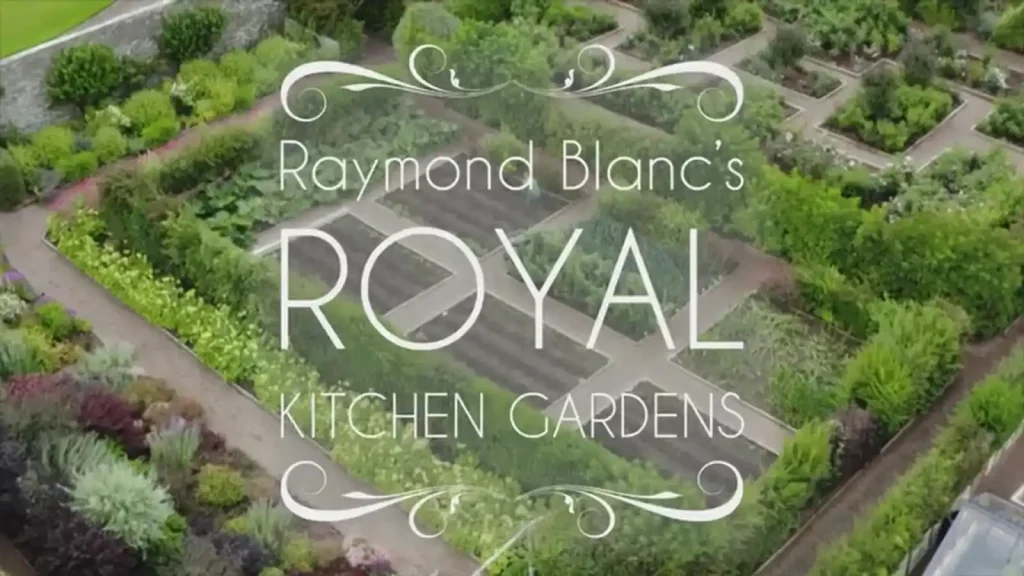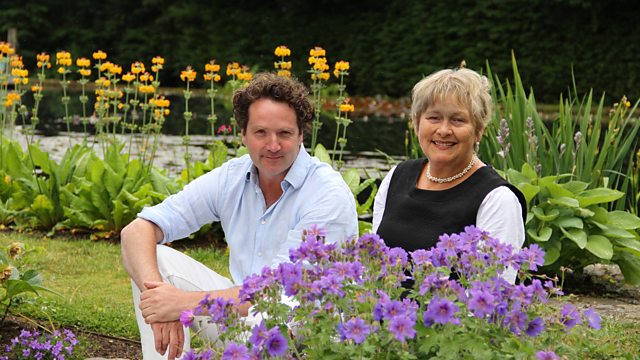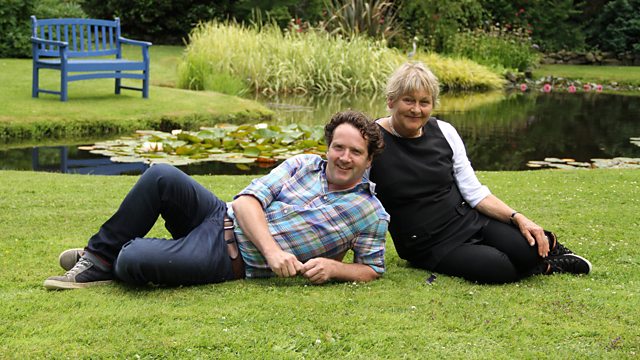Raymond Blanc’s Royal Kitchen Gardens episode 9: In the heart of Northern Ireland stands the grand Hillsborough Castle, an architectural marvel adorned with opulent interiors and surrounded by expansive, picturesque gardens. This regal residence serves as the official home for the royal family when they are in Northern Ireland. In the ninth episode of Raymond Blanc’s captivating documentary series, “Royal Kitchen Gardens,” we are taken on an enchanting journey through this historic estate.
Raymond Blanc, the renowned chef known for his passion for gardening and culinary excellence, brings a unique perspective to this visit. Hillsborough Castle is not just a stately home but a place rich in history and natural beauty. The castle’s gardens, meticulously maintained and flourishing with a variety of plants, offer a serene escape from the bustling world.
As Raymond strolls through the lush, green landscapes, he reflects on the history that permeates the very soil of these gardens. These grounds were once frequented by a young Queen Elizabeth, who found solace and inspiration among the tranquil flora. Her footsteps have graced these pathways, adding an air of royal charm to the already majestic surroundings.
The gardens of Hillsborough Castle are a testament to centuries of horticultural dedication. From the meticulously trimmed hedges to the vibrant flowerbeds, every corner of the garden tells a story. Ancient trees, some of which have stood for hundreds of years, provide shade and a sense of continuity, bridging the past with the present. The carefully planned layout of the gardens reflects the changing tastes and influences of the various periods in which they were developed.
During his visit, Raymond Blanc delves into the art of garden design, exploring the various elements that make Hillsborough’s gardens so unique. He converses with the head gardener, uncovering the secrets behind the thriving plant life and the techniques used to maintain such a diverse and vibrant ecosystem. Their discussion reveals not only the beauty of the gardens but also the hard work and expertise required to sustain them.
One of the highlights of Raymond’s visit is his encounter with the vegetable garden. Tucked away within the expansive grounds, this area is a treasure trove of fresh, organic produce. The sight of peas, beans, and various other vegetables growing in neat rows is a testament to the castle’s commitment to sustainability and self-sufficiency. Raymond’s excitement is palpable as he picks a few peas, appreciating their crisp texture and sweet flavor.
Inspired by the fresh produce, Raymond heads to the castle’s kitchen to prepare a dish that captures the essence of Hillsborough’s gardens. He decides on a succulent pork chop, perfectly seasoned and cooked to perfection. To complement the rich flavor of the meat, he prepares a cabbage dish, its leaves tender and full of flavor. The final touch is a gooseberry compote, its tartness balancing the richness of the pork and the earthiness of the cabbage. This dish is not just a meal but a celebration of the natural bounty that Hillsborough’s gardens offer.
Raymond Blanc’s Royal Kitchen Gardens episode 9
Throughout the episode, Raymond’s genuine admiration for Hillsborough Castle and its gardens is evident. His journey is not just about exploring a historic site but about connecting with the living legacy of the royal family and the natural world they have nurtured. Each scene is filled with lush visuals and heartfelt commentary, making it clear that this is a place where history, nature, and culinary art converge.
The episode concludes with Raymond reflecting on the importance of preserving such historic and natural treasures. Hillsborough Castle, with its rich history and stunning gardens, serves as a reminder of the enduring beauty and significance of these royal estates. It is a place where past and present meet, where the young Queen Elizabeth once wandered and where today, people can still find peace and inspiration.
Raymond Blanc’s visit to Hillsborough Castle is a poignant reminder of the connection between the land, its history, and the people who care for it. The gardens are not just a backdrop but a living, breathing part of the estate, each plant and pathway contributing to the overall story. Through his culinary creations, Raymond pays homage to this story, crafting dishes that are deeply rooted in the heritage and natural abundance of the castle’s grounds.
In “Royal Kitchen Gardens,” Raymond Blanc not only showcases his culinary prowess but also his deep respect for the historical and horticultural heritage of the places he visits. Episode 9, set in the stunning Hillsborough Castle, is a perfect blend of history, nature, and gastronomy, offering viewers a rich and immersive experience that goes beyond the surface to explore the very heart of this magnificent estate.
The Royal Kitchen Garden Renaissance
Raymond Blanc’s Passion for Sustainable, Seasonal Food
In the lush heart of Britain’s countryside, a culinary revolution is taking root. At the forefront stands Raymond Blanc, a chef whose eyes sparkle with the same vibrant intensity as the freshly picked produce he champions. His passion for sustainable, seasonal food isn’t just a fleeting trend; it’s a lifelong love affair with nature’s bounty.
Imagine walking through Blanc’s garden at Le Manoir aux Quat’Saisons, where rows of vibrant vegetables stretch as far as the eye can see. Here, every leaf and fruit tells a story of careful nurturing and respect for the earth. For Blanc, this isn’t merely about growing food; it’s about cultivating a deeper connection between plate and planet.
King Charles III’s Championing of Kitchen Gardens
As Blanc tends to his verdant paradise, he’s not alone in his horticultural pursuits. In fact, he’s in royal company. King Charles III, long before ascending to the throne, has been a steadfast advocate for kitchen gardens. His dedication to this cause is as enduring as the ancient oaks that grace the grounds of royal estates.
The King’s commitment goes beyond mere gardening; it’s a crusade for biodiversity and environmental stewardship. Through his efforts, kitchen gardens have transformed from quaint relics of the past into powerful symbols of sustainable living. His Royal Highness has effectively sown the seeds of a green revolution, inspiring a nation to rediscover the joys of homegrown produce.
The Historical Significance of Royal Kitchen Gardens
To truly appreciate the renaissance of royal kitchen gardens, we must first delve into their rich history. These gardens are not just patches of earth; they’re living museums, preserving centuries of horticultural wisdom. From the meticulously planned gardens of Hampton Court Palace to the innovative designs at Kew, royal kitchen gardens have long been at the forefront of agricultural innovation.
In centuries past, these gardens were more than just a source of fresh produce for the royal table. They were status symbols, showcasing exotic plants from far-flung corners of the empire. Moreover, they served as living laboratories where new cultivation techniques were developed and tested. Today, as we face global challenges like climate change and food security, these historical gardens offer valuable lessons in resilience and sustainability.
As we witness the revival of royal kitchen gardens, we’re not just observing a trend; we’re participating in a movement that connects us to our roots while paving the way for a greener future. This renaissance is more than a return to tradition; it’s a bold step towards a more sustainable and delicious world.
A Journey Through Hillsborough Castle’s Edible Treasures
Exploring the Restored 4-acre Kitchen Garden
Step into the verdant oasis of Hillsborough Castle’s kitchen garden, and you’ll find yourself transported to a world where history and horticulture intertwine. This 4-acre plot, once a forgotten relic, now stands as a testament to the enduring power of restoration and sustainable gardening practices.
As you wander through the neatly manicured rows, the air thick with the scent of herbs and ripening fruit, it’s hard to imagine that just a few years ago, this space lay dormant. The garden’s rebirth is nothing short of miraculous, a phoenix rising from the ashes of neglect. Today, it’s a living, breathing entity, pulsing with the rhythms of nature and the careful ministrations of dedicated gardeners.
Harvesting and Cooking with Garden-Fresh Produce
Picking Peas and Discussing Heirloom Varieties
There’s something almost magical about plucking a plump pea pod from the vine. As Raymond Blanc demonstrates this simple act, his eyes light up with childlike wonder. “These are Blauschokker peas,” he explains, his accent lending a musical quality to the words. “An heirloom variety with a history as rich as its flavor.”
Heirloom vegetables, with their quirky shapes and vibrant hues, are more than just a feast for the eyes. They’re living links to our agricultural past, each variety telling a story of the farmers who carefully selected and saved seeds over generations. As we sample the peas, their sweetness exploding on our tongues, it’s clear why these forgotten treasures are worth preserving.
Discovering Heritage Apple and Pear Trees
Moving deeper into the garden, we encounter gnarled apple and pear trees, their branches heavy with fruit. These aren’t just any trees; they’re living antiques, some over a century old. “Look at this Comice pear,” Raymond says, gently cradling a fruit in his hand. “It’s a French variety, but it’s found a happy home here in Ireland.”
Each tree in this orchard is a survivor, having weathered countless seasons and changes in gardening fashion. Yet they continue to bear fruit, a testament to the resilience of nature and the wisdom of traditional farming practices. As we bite into a crisp apple, its complex flavors dancing on our palates, it’s clear that these heritage varieties offer something that modern, mass-produced fruit simply can’t match.
Reviving Interest in Forgotten Fruits like Gooseberries
At the far end of the garden, we come across a patch of plants bristling with thorns. “Ah, the humble gooseberry,” Raymond chuckles. “Once a staple in British gardens, now almost forgotten.” But here at Hillsborough, these tart little berries are making a comeback.
As we carefully harvest the fruit, mindful of the sharp thorns, Raymond explains the gooseberry’s fall from grace. “They were too tart, too difficult to pick,” he says. “But with new varieties and a renewed appreciation for complex flavors, they’re finding their way back into our kitchens.” Tasting a ripe berry, its flavor a perfect balance of sweet and sour, it’s easy to see why this forgotten fruit deserves a second chance.
In this garden, every plant, every fruit, and every vegetable tells a story. It’s a living library of flavors, a testament to the rich tapestry of our culinary heritage. As we leave, baskets laden with the day’s harvest, there’s a sense of connection – to the land, to history, and to the endless possibilities that await in the kitchen.
From Garden to Table: Culinary Creations
Raymond Blanc’s Pork Chop with Cabbage and Gooseberry Compote
Picture this: a sizzling pan, the aroma of herbs wafting through the air, and Raymond Blanc, his eyes twinkling with culinary mischief. He’s about to transform simple ingredients into a masterpiece. “Today, we celebrate the forgotten treasure – the gooseberry,” he announces, holding up a handful of the tart, green jewels.
As Raymond deftly prepares the dish, he shares his philosophy. “This is not just cooking; it’s a love letter to the garden,” he explains, carefully laying a thick pork chop in the pan. The meat hisses and spits, releasing a mouthwatering scent. Meanwhile, he turns his attention to the gooseberries, gently simmering them with a touch of sugar. “We’re not masking their tartness,” he says, “we’re embracing it.”
Showcasing the Versatility of Gooseberries
The gooseberry compote bubbles away, its color transforming from pale green to a vibrant ruby. Raymond explains how this often-overlooked fruit can be a game-changer in the kitchen. “It’s not just for desserts,” he insists, spooning the compote over the golden-brown pork chop. “The tartness cuts through the richness of the meat, creating a perfect balance.”
But Raymond doesn’t stop there. He demonstrates how gooseberries can elevate both sweet and savory dishes. “Imagine this compote with a creamy panna cotta,” he suggests, his hands gesturing expressively. “Or mixed into a chutney for your cheese board.” As he speaks, it’s clear that in his hands, the humble gooseberry becomes a culinary superstar.
Step-by-Step Cooking Demonstration
With the precision of a surgeon and the flair of an artist, Raymond guides us through each step of the cooking process. He starts with selecting the perfect pork chop – “Look for marbling,” he advises, “it’s where the flavor lives.” Then, he demonstrates the importance of properly seasoning the meat before it hits the pan.
As the pork sizzles, Raymond turns his attention to the cabbage. “This is not the boiled cabbage of school dinners,” he chuckles, slicing the vegetable into thin ribbons. He quickly sautés it with a knob of butter, explaining how this method preserves the cabbage’s crunch and sweetness. The result is a vibrant green side dish that’s a far cry from the mushy vegetables many associate with British cuisine.
Emphasizing Simple, Home-Style Cooking
Throughout the demonstration, Raymond emphasizes that this dish is not about fancy techniques or exotic ingredients. “This is the kind of meal anyone can make at home,” he insists, plating up the pork chop with a flourish of gooseberry compote and a nest of buttery cabbage. The result is a plate that looks like it belongs in a high-end restaurant but is achievable in any home kitchen.
Raymond’s approach to cooking is all about respecting the ingredients and letting their natural flavors shine. “When you have produce this fresh, you don’t need to do much,” he explains, taking a bite of the finished dish. His eyes close in appreciation as he savors the combination of flavors – the rich pork, the tart gooseberries, and the sweet crunch of cabbage.
As we watch Raymond enjoy his creation, it’s clear that this dish is more than just a meal. It’s a celebration of the garden, a showcase of seasonal cooking, and a testament to the joy that can be found in simple, well-prepared food. It’s an invitation to all of us to reconnect with our kitchens, our gardens, and the timeless pleasure of cooking with fresh, seasonal ingredients.
F.A.Q. Raymond Blanc’s Royal Kitchen Gardens episode 9
Q.: What is Hillsborough Castle and its significance in “Royal Kitchen Gardens” episode 9?
A.: Hillsborough Castle is the official residence of the royal family in Northern Ireland, known for its opulent interiors and expansive, picturesque gardens. In episode 9 of “Royal Kitchen Gardens,” Raymond Blanc explores this historic estate, highlighting its rich history and natural beauty.
Q.: What unique perspective does Raymond Blanc bring to his visit to Hillsborough Castle?
A.: Raymond Blanc, a renowned chef with a passion for gardening and culinary excellence, provides an insightful look at Hillsborough Castle’s gardens. His visit focuses on the art of garden design, sustainability, and the historical significance of the grounds, enhancing the connection between the estate’s natural beauty and its culinary potential.
Q.: How does the history of Hillsborough Castle’s gardens contribute to the episode’s narrative?
A.: The gardens of Hillsborough Castle, frequented by a young Queen Elizabeth, are rich in history and horticultural dedication. Raymond Blanc reflects on this heritage, showcasing how the gardens have evolved over centuries and how they continue to be a serene escape and a source of inspiration.
Q.: What culinary dish does Raymond Blanc prepare in the episode, and what inspired it?
A.: Inspired by the fresh produce from Hillsborough Castle’s vegetable garden, Raymond Blanc prepares a succulent pork chop with a side of tender cabbage and a tart gooseberry compote. This dish captures the essence of the garden’s bounty, celebrating the natural flavors and sustainability of the estate’s produce.
Q.: What message does Raymond Blanc convey about the importance of preserving historic gardens like those at Hillsborough Castle?
A.: Raymond Blanc emphasizes the significance of preserving historic gardens for their cultural, historical, and environmental value. He highlights how these gardens, with their rich heritage and sustainable practices, serve as living legacies that bridge the past with the present and inspire future generations to appreciate and protect such treasures.
Conclusion Raymond Blanc’s Royal Kitchen Gardens episode 9: A Feast for the Senses
The Enduring Appeal of Kitchen Gardens
As we bid farewell to the lush greenery and vibrant produce of Hillsborough Castle’s kitchen garden, we’re left with a profound sense of wonder. These gardens, with their neat rows of vegetables and fruit-laden trees, are more than just sources of food. They’re living, breathing testaments to our connection with the earth.
The appeal of kitchen gardens lies not just in their productivity, but in their ability to engage all our senses. The sight of sun-ripened tomatoes, the scent of fresh herbs, the feel of soil between our fingers – all these experiences remind us of our primal connection to nature. In a world increasingly dominated by technology, these gardens offer a much-needed respite, a chance to reconnect with the rhythms of the natural world.
Encouraging Sustainable and Seasonal Eating
The resurgence of kitchen gardens isn’t just a nostalgic nod to the past; it’s a vital step towards a more sustainable future. By growing our own food or supporting local growers, we’re reducing food miles and our carbon footprint. Moreover, we’re rediscovering the joys of eating with the seasons.
Imagine biting into a sun-warmed strawberry in June, or savoring the earthy sweetness of a freshly dug potato in autumn. These simple pleasures are what seasonal eating is all about. It’s not just about taste, though that’s certainly a bonus. Seasonal eating also means consuming foods when they’re at their nutritional peak. Plus, it encourages us to diversify our diets, trying new vegetables and fruits as they come into season.
Celebrating the Marriage of Gardening and Gastronomy
The kitchen garden stands at the intersection of two great human endeavors: cultivation and cuisine. It’s where the gardener’s patience meets the chef’s creativity, resulting in dishes that are truly greater than the sum of their parts. This marriage of gardening and gastronomy is not just about producing food; it’s about creating experiences.
Think about the satisfaction of serving a meal made entirely from ingredients you’ve grown yourself. Or the joy of experimenting with heritage varieties of vegetables, rediscovering flavors that have been all but lost to modern agriculture. These experiences connect us not just to our food, but to our cultural heritage and to each other.
As we leave Hillsborough Castle, our senses still buzzing with the sights, smells, and tastes of the kitchen garden, we carry with us a renewed appreciation for the simple act of growing food. We’re inspired to get our hands dirty, to plant a seed and nurture it to fruition. Whether it’s a windowsill herb garden or a full-fledged vegetable plot, we’re ready to embark on our own gardening adventures.
The revival of kitchen gardens, championed by figures like Raymond Blanc and King Charles III, isn’t just a trend. It’s a movement, a return to values that have sustained us for millennia. It’s about reconnecting with our food, our environment, and ultimately, ourselves. So let’s take this inspiration and turn it into action. Whether it’s starting our own garden, supporting local farmers, or simply cooking more with seasonal ingredients, we all have the power to make a difference, one meal at a time.




